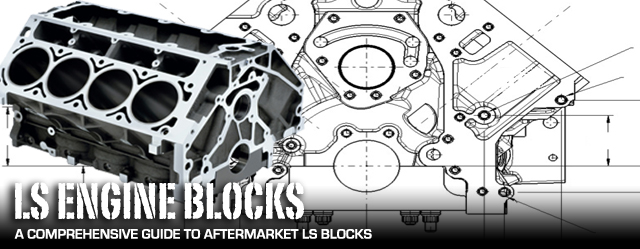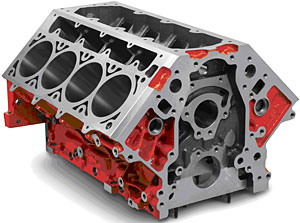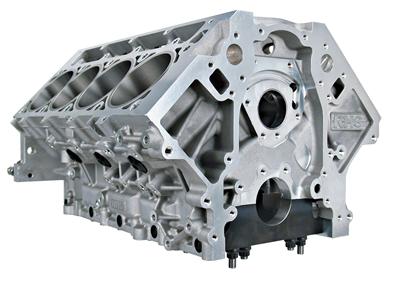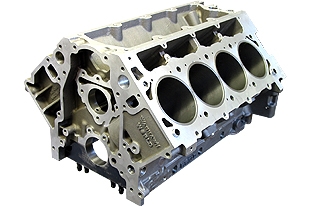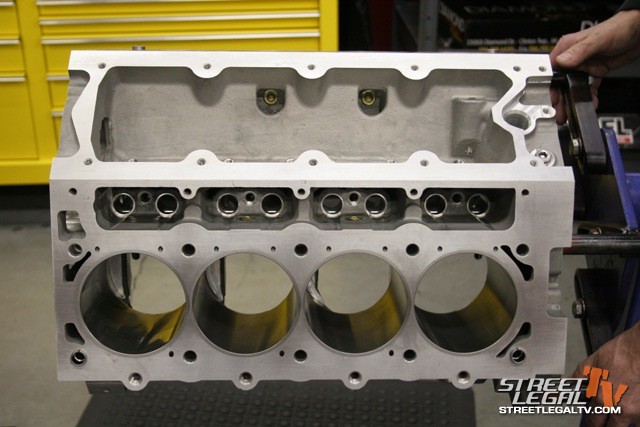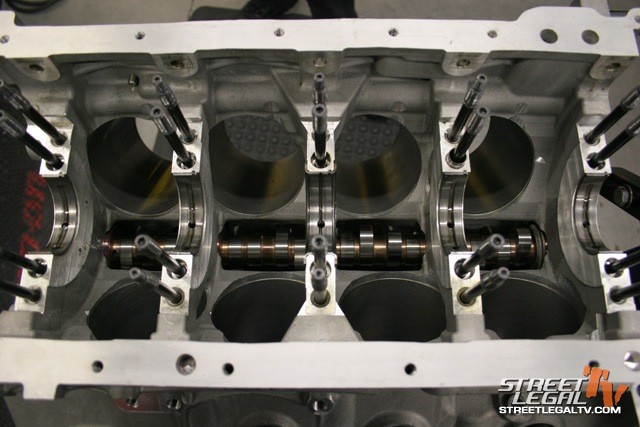If you are an engine builder putting together an LS engine, there has never been as many options available as there are now. From full on hardcore race engines to tamed down street motors, the choices in parts can be overwhelming. We wanted to get a handle on the plethora of components and see if we could make it easier to see the full landscape of engine pieces, starting with aftermarket engine blocks.
The cornerstone to any engine build is the cylinder block and the foundation to a great engine build is picking the right cylinder block for your application and budget. Aftermarket engine blocks used to be an item that was only for the high end racer but manufacturing processes have made many of these blocks affordable for every application. With this many options available to them, many engine builders dismiss the thought of using a reconditioned junkyard block and start their build from scratch with a fresh new aftermarket block.
Helping us understand the options available were a handful of experts from the engine block manufacturing world. We talked with:
- Billy Mitchell Jr. from World Products
- Jack McInnes from Dart Machinery
- Kevin Feeney from RHS Racing Head Service
- Rocko Parker from General Motors Performance Parts
For a “real world” perspective on aftermarket LS Blocks, we enlisted the help of Billy Briggs of Briggs Performance and Steve Petty of Pro Line Racing.
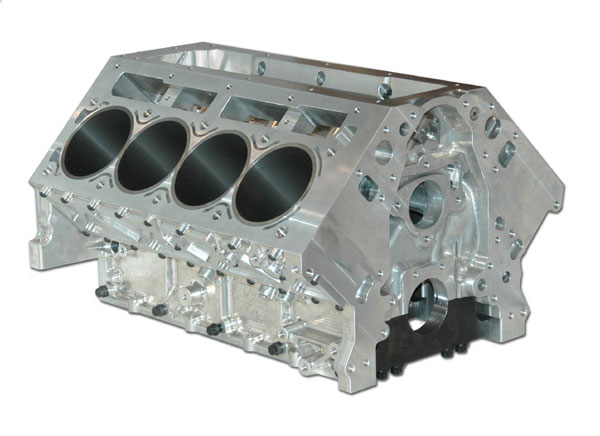
Dart's billet block is completely custom - that means that any dimension or configuration you want for your LSX billet race block can be yours. That's one of the main advantages of billet as a material. The downside..? It's pricey.
Dart Machinery’s LS Billet Block
Our engine builders were pretty specific about Dart Machinery’s single entry into the LS block market. According to Dart Machinery’s Director, Jack McInnes, the LS1 billet block is “perfect for the engine builder that is looking for premium block to start their engine build with. The fact that it’s not a casting and is machined out of a single piece of billet aluminum means that it’s unique. There’s nothing else on the market like it. It’s in a league of it’s own.
“It can be whatever the engine builder wants it to be. You can order custom deck heights, custom cam locations or custom whatever.” McInnes went on to say, “the billet material is so far beyond a casting as far as integrity, tensile strength and fatigue strength that it’s hard to compare it to anything else on the market.”

“One of the most impressive things in the design of this block is it’s increased capacity water jacket. Most people have a hard time understanding that when you take a large chunk of aluminum and create an engine block out of it, that it’s possible to machine a full water jacket in the block,” McInnes explained.
Billy Briggs supported the claim that Dart’s LS1 Block was an affordable clean slate to work with. “I can count on ordering a custom bore or deck height from Dart and have it show up precisely as I ordered with no additional machine work required. The Dart LS blocks cost a little more on the front end but when you compare it to some other aftermarket blocks that cost less initially but require a bit of machine work on this end, the total ‘real’ cost is nearly the same.”
McInnes professes that the quality of the LS1 billet block is unmatched, “While the repairability of the billet block is easier if you should hurt the block, I can’t recall ever having anyone actually damage one of these blocks. These blocks really pay off in the longevity and quality.”
Dart Machinery opted to go with a billet LS block instead of a cast block due to challenges with consistency in casting an Aluminum LS block. McInnes stated, “The billet is so much more dense and consistent, plus it makes this block almost indestructible and easy to repair if it does get damaged. Consistency in quality was the driving factor in our selection to only produce LS blocks in billet aluminum.”
Features of Dart Machinery’s LS Billet Block:
- Forged 6061 aerospace alloy with proprietary heat treatment for maximum strength and stability.
- Custom machined for your application
- Custom deck height options
- Raised camshaft locations
- Cam tunnel options to 60mm
- Custom lifter diameters
- Steel main caps
- Full water jackets
Summary: It’s perfect for a hardcore drag racer that will spend the big money to have the best, assuming class rules permit it.
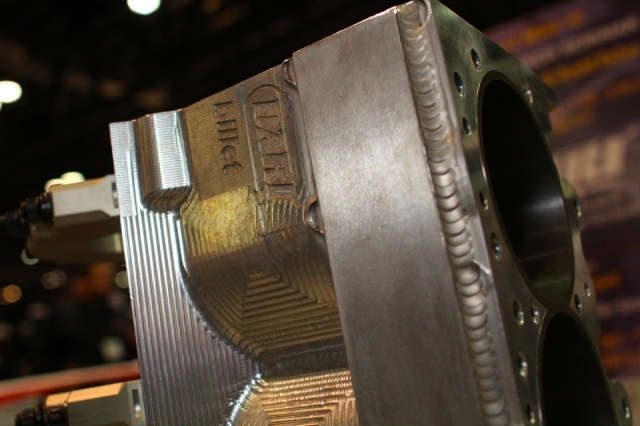
It's a common misconception that billet blocks can't - or don't - have water jackets. Dart can engineer a water jacket into practically any aluminum LSX block.
Chevy Performance LSX Block
The folks at GMPP sometimes downplay their place in the aftermarket high performance parts market when in reality, they have really produced some of the nicest factory pieces to ever hit the market.
We’ve checked in with Brian Thomson of Thomson Automotive Engines several times over the years concerning the LS platform. Thomson is considered one of the foremost authorities in LS engines having participated in much of the GM third party testing of the engine platform as the engine was being developed and participated in testing each version of the engine product line. According to GMPP’s Dr. Jamie Meyer, when asked about Thomson, “He’s done as much with LS engines as anyone.”
Thomson’s take on the GMPP blocks; “GM’s LS blocks are strong and make good power. They really put out a good product and they want it to last a long time for people. These blocks are engineered strong and hold up really well.”
To verify the LS block’s ability to withstand all out race competition at record levels, we called Steve Petty of Proline Race Engines. Petty, founder of the company and now serves as tuner and engine consultant, carved out a name for himself in Outlaw 10.5 drag racing. He was the first to break into the sixes on 10.5 tires, and has been the first to achieve every mark since that point. We asked Petty why he uses GMPP’s LS blocks when putting together motors. “The LSX blocks are quality pieces that are very affordable and only require a very small amount of massaging to make extreme horsepower,” said Petty.
GMPP Non Production Blocks:
There are three GM non-production LS series blocks offered by GMPP. The C5R block was developed for the factory based Corvette racing program and have been manufactured in small quantities, while the LSX bowtie standard and tall deck blocks have been produced since 2007 to support high performance combinations.
- C5R (Part #12480030) Aluminum, 9.240” deck, 4.117” – 4.160” bore, 4.10” max stroke.
- LSX Bowtie standard deck (Part #19213964) Iron, 9.260” deck, 3.880” bore, 4.25” max stroke.
- LSX Bowtie tall deck (Part #19213964) Iron, 9.720” deck, 3.880” bore, 4.50” max stroke.
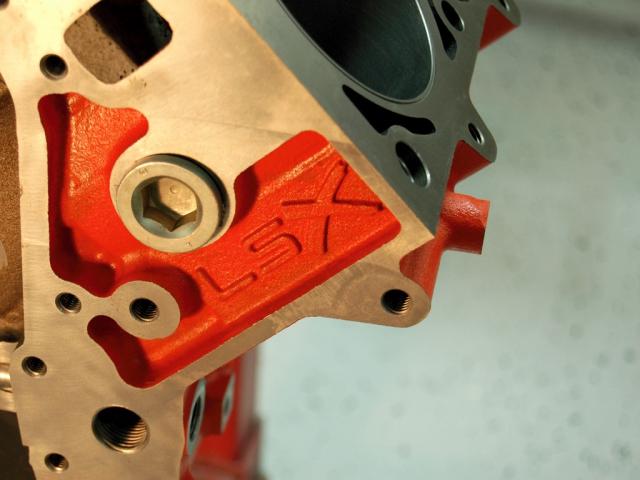
The LSX block is available in both standard (9.260″ semi-finished, ready to be decked) and tall (9.720″ semi-finished) deck heights.
For the purposes of this story, we’re going to ignore the C5R. Why? It’s expensive and less relevant than ever. Instead, we’d like to focus on the LSX iron casting GM Performance Parts developed to offer race-worthy strength at an affordable price. The block features 6 head bolts per cylinder, LS7-style 6-bolt dowel located billet main caps, and a bunch of other performance-oriented features not necessarily found on production LS blocks. It can support upwards of 2,500 horsepower and costs about $2,000.
Here are some key features of the block:
- True priority main oiling
- Wet or dry sump oiling capability
- Production style deep skirt head bolt holes
- Front motor plate mounting holes
- Additional material cast around cam bearing holes
- Cam bores machined for supplied bearings
- Main web bay-to-bay breathing holes
- Threaded water plugs
Summary: The LSX block is the standard bearer of the class. Inexpensive for what you get, it can take a beating and keep on ticking. However, machine work is going to be more extensive on the LSX block than either the Dart or RHS, and it is heavy (as all iron blocks are).
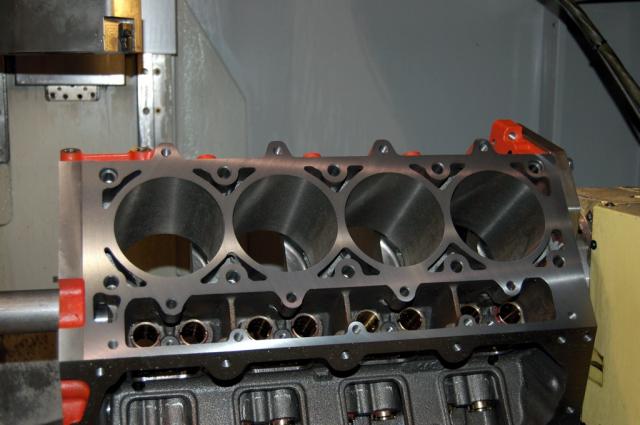
Extra-thick siamesed cylinder bores with standard 4.400″ spacing, along with 6-bolt head configuration means a super strong deck surface that won't distort under high cylinder pressures.
RHS (Racing Head Service) LS Block
RHS is the newest player in the game, and the one probably making the most waves at the high end of the marketplace. When you see a serious, serious, big-dollar LS engine being built – it’s probably using an RHS block. Top builders like VA Speed and LME engines employ the RHS block as the ultimate in light weight and durability. At a street price over $4k, it’s not for the casual street guy.
We did a full tech story on the block, and during this story, RHS Product Manager Kevin Feeney got right to the point when talking about LS Blocks, “The limitation on the stock LS engine is definitely stroke and we have designed specifically for a long stroke application, however you also need to consider deck height as well to take advantage of the long stroke. There are engine buiders adding deck plates to raise the deck on the OE blocks but you are limited on the stroke. We have taken advantage of both with our design.”
RHS has raised the camshaft centerline .388” to allow for the longer stroke but this does not cause problems with timing set. “This is the exact dimension required to use a stock set of gears with a timing chain that is 2 links longer,” said Feeney. Engine builder Briggs added;”These timing sets are readily available, and COMP Cams makes them in either single row or double chain or belt drives.” RHS also has the timing sets available or you can order just the longer timing chain from RHS for use with the stock gears. For the gear drive fanatics, RHS also has a gear drive timing set available.
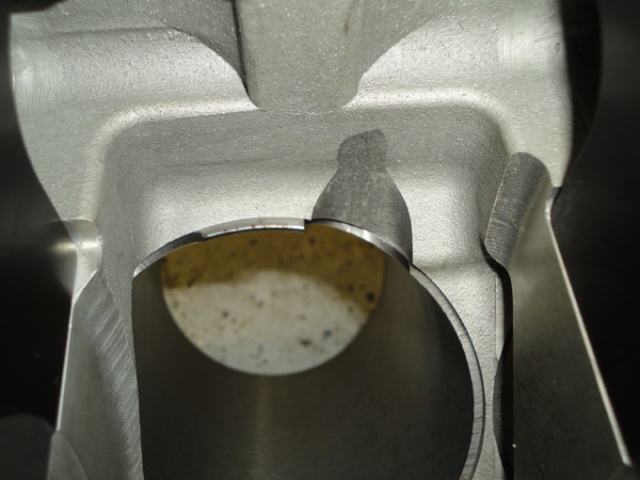
With a nasty stroker crank, you'll need to notch many blocks. Not the RHS block - it comes pre-notched, even the sleeve is clearanced.
Feeney explained that the angle of the pushrod was a concern when they were designing the raised camshaft centerline, “We were concerned, especially on a standard deck application, but after extensive analysis we determined that there was only a two degree change in pushrod angle in the worse case scenario.” Feeney added that “the plus side to raising the cam centerline is not only for stroke clearance, but the shorter pushrod is a benefit to adding rigidity to the valve train.”
Briggs also pointed out that using a longer stroke can cause problems on the bottom skirt of the block requiring special oil pans to allow room for the crankshaft swing of the longer stroke. Feeney explained that they were able to “design clearance in the block while utilizing the stock oil pan rails.” According to Feeney, the design for additional clearance required the oil system to be redesigned to a “priority main oiling with an enlarged main oil gallery moved outboard to provide extra clearance.”
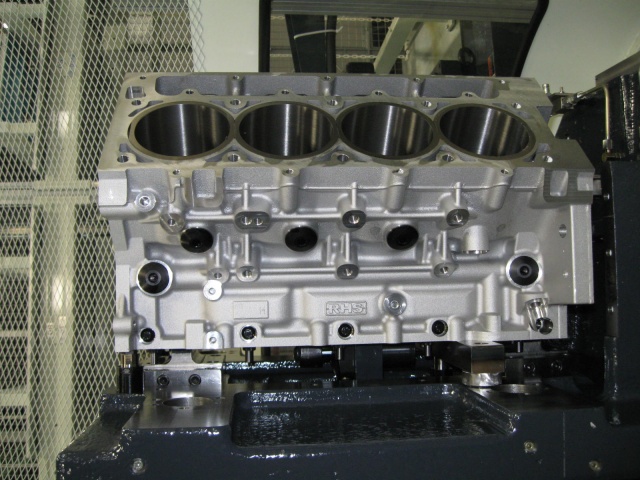
Check out the webbing on the RHS block. This is a block designed from day 1 as a serious race block, or for nasty street engines making 1,000-plus HP.
RHS engineers found another area of concern with stock LS Blocks in the form of windage due to the longer stroke in-conjunction-with block skirt. “We increased the bay to bay breathing area over the stock LS and LSX blocks to help improve this,” said Feeney.
RHS LS Aluminum Race Blocks are available in these deck and bore combinations:
- Tall Deck, 9.750” Deck, 4.165” Bore (Part #54900)
- Tall Deck, 9.750” Deck, 4.160” Bore (Part #54900U)
- Tall Deck, 9.750” Deck, 4.125” Bore (Part #54901)
- Tall Deck, 9.750” Deck, 4.120” Bore (Part #54901U)
- Standard Deck, 9.240” Deck, 4.165” Bore (Part #54902)
- Standard Deck, 9.240” Deck, 4.160” Bore (Part #54902U)
- Standard Deck, 9.240” Deck, 4.125” Bore (Part #54903)
- Standard Deck, 9.240” Deck, 4.120” Bore (Part #54903U)
- Standard Deck, 9.760” Deck, 4.100” Bore (Part #54904)
- Standard Deck, 9.250” Deck, 4.100 Bore (Part #54905)
Summary: Most popular aftermarket aluminum block, with the best reputation for power, durability, and casting precision. Great for a 2,500 hp race engine, or a nasty turbo street motor.
“World was the first aluminum aftermarket LS block capable of big horsepower,” says Billy Mitchell Jr, Director of Marketing at World Products. While the definition of big horsepower and who was first can be debated over and over again, the fact that World Products is no stranger to GM engines is cannot be questioned. Starting with the venerable small block 350, World Products has focused on manufacturing very effective engine blocks and cylinder heads for GM fanatics.
For the LS fans, World Products Warhawk line of replacement blocks for GM’s LS1, LS7 and C5R engines have been big news for the company. According to Mitchell, the Warhawks are “offered in 9.240″ and 9.800″ deck heights with priority main oiling system.” With bigger horsepower engines, cylinder walls can “balloon out,” especially when there is not enough material to support the cylinder walls under extreme pressure.
“The Warhawk’s water jackets are redesigned from the stock GM design to allow for more aluminum behind the ductile iron sleeves to prevent the cylinders from ballooning out,” Mitchell added, “The ductile iron sleeves are pressed in and are replaceable.” With replaceable cylinder sleeves, it’s possible that a World block can last for several seasons just by replacing the sleeves whenever wear becomes an issue.
Mitchell also explain other differences in the Warhawk block, “The block has two extra head bolt holes per cylinder to help keep the head gaskets from pushing out and the block itself is made out of 357T6 aluminum.”
World Products Warhawk blocks are available in these deck and bore combinations:
- 9.240” Deck, 3.990” Bore (Part #086505)
- 9.240” Deck, 4.115” Bore (Part #086515)
- 9.800” Deck, 4.115” Bore (Part #086525)
Summary: A good option to look into for an affordable block that has a track record in the 6-second zone.
Size Matters
As we have seen above, aftermarket LS blocks can come in practically any deck height or bore size that you could ever want. If something is unavailable off the shelf, then a Dart custom billet block with whatever specification you desire is even available. With this many options, a block can be found that would accommodate a build from street use to all out track use.
Street, strip or marines use, these companies have you covered and based on what we’ve seen, you could even find an LS block capable of powering a rocket ship in sub orbital flight (LS blocks destined for flight outside of the atmosphere require the user to supply oxygen for combustion!). Regardless of the application, there is an aftermarket LS block that will perform beyond expectations and not require you to have a NASA type project budget.
Whatever LS block you choose, it’s certain that you will have a safe flight.



